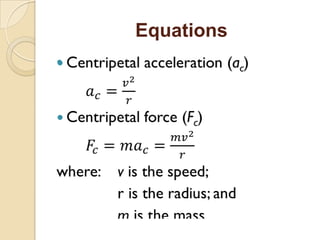Ucm
- 2. Target Todefine period, frequency, uniform circular motion, centripetal acceleration, centripetal force and centrifugal force; To identify the forces acting on a body moving in a circular path;
- 3. Target Toderive the equation for centripetal force from Newton’s second law of motion; Tocite applications of centripetal force; and To solve problems related to circular motion.
- 5. Period and Frequency Period (T) is the Frequency (f) is time required for the number of a body to make revolutions one complete completed by a revolution. body in a given time. Units: s, min, hr. or Units: yr. rev/s, rev/min, rev/hr. or rev/yr.
- 6. Uniform Circular Motion Itis the motion of a body that moves in a circular path at constant speed.
- 7. Centripetal acceleration The inward acceleration of a body moving in circular motion.
- 11. Forces Centripetal Centrifugal force is the force is the force that force that is pulls a body directed inward when away from moving in a the center of circular path. a circular path.
- 12. Examples
- 13. Examples
- 14. Equations
- 15. Equations
- 16. Equations
- 17. Sample Problem 1 A little girl is playing with her skip ball. The ball is in uniform circular motion and makes 20 revolutions in 4 s. (a) What is its period? (b) What is its frequency? (c) If the length of the cord that holds the ball is 0.8 m, what is its speed? (d) If the ball’s mass is 3 g, how much force is acting on the ball to keep it in uniform circular motion?
- 18. Sample Problem 1 Given: no. of rev = 20 time = 4 s lengthcord = 0.8 m mass = 3 g Find: a. T c. v b. f d. Fc
- 19. Sample Problem 2 A 0.1-kg mass is attached to a 0.9-m length of string. The weight is swung in a horizontal circle, making one revolution in 1.2 s. (a) Find the speed of the mass. (b) What is its centripetal acceleration? (c) What is the force that the string exerts on it?
- 20. Sample Problem 2 Given: mass = 0.1 kg lengthstring = 0.9 m no. of rev = 1 time = 1.2 s Find: a. v b. ac c. Fc




















